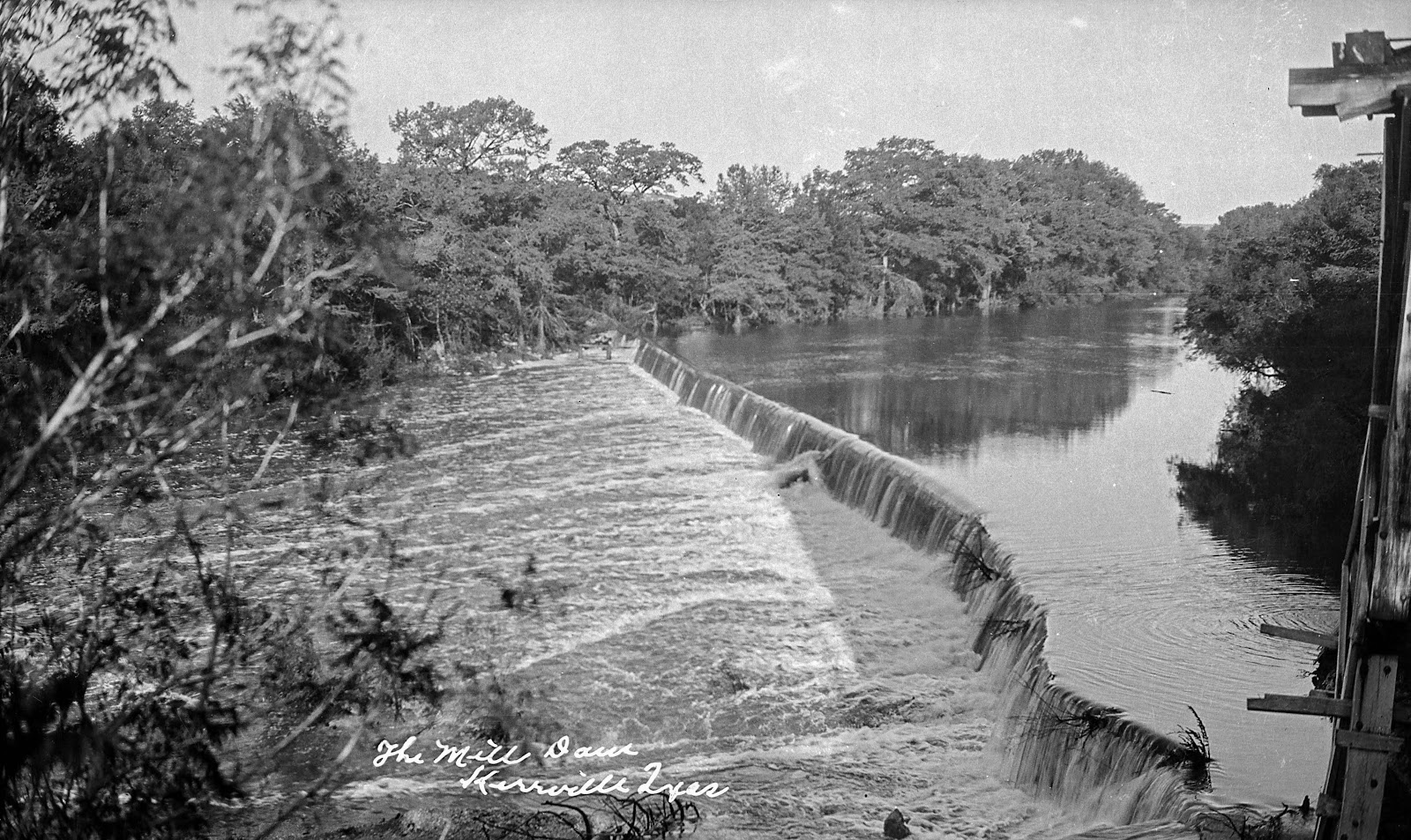 |
| Searching for the oldest settler-made structure in Kerrville. Click on any image to enlarge. |
Consider the old buildings in downtown Kerrville. Since Kerr County was created in 1856, what is the oldest man-made structure in downtown Kerrville?
The answer might surprise
you.
It rests at the bottom of
a bluff littered with debris from other, newer structures, and is hidden within
a wild tangle of branches, vines, and weeds. Trash is piled in drifts at the
site: food wrappers, clothes, broken glass; it's filthy.
 |
| Christian Dietert |
Most who pass by would
not recognize it. It looks like a pile of stones, though parts still look very
similar to their appearance at least a century ago.
To see the old mill, you
have two options. You can visit One Schreiner Center, and walk out on the
remains of the old ice plant and look down. Or, if you have extra energy, you
can go to the pavilion at the end of Earl Garrett Street, and take the stairs
down. The ruins of the old mill are just past the foot bridge that crosses the
Guadalupe River below the dam in Louise Hays Park.
The remaining mill structure
is older than the oldest commercial building in town, the Favorite Saloon
building, at 709 Water Street. That building was built in 1874, three years
before the railroad arrived in Kerrville, meaning every bit of material used in
its construction was either sourced locally, or hauled here in a wagon.
The original mill on the site was built by Christian Dietert with help from Balthasar Lich around 1857. Of course that original structure was altered and improved over the years, and destroyed more than once by flood waters, and it's possible there is not an original stone left on the site from the original construction. It's my belief at least some of the old original mill remains, even if it's only the cuts in the limestone where water discharged from the water wheel.
I found a nice story
about the Dieterts in an old issue of Hunter's "Frontier Times
Magazine" written by T. U. Taylor in 1941.
Christian Dietert was a
millwright born in Tesen, Germany, in 1827. In 1854 he voyaged to Texas with
his brother William on a 4-masted sailing vessel; the trip took five months,
and the pair arrived in New Braunfels in July.
The very next month
Christian joined a company of 13 men who journeyed to the confluence of the
Guadalupe River and Cypress Creek to survey a tract of land and help lay out
the town of Comfort.
In 1855 Christian Dietert
built a mill on Cypress Creek, but only two months after completion, the little
mill had to be abandoned: Cypress Creek ran dry, and the mill was discarded for
lack of water power.
In 1856 Christian
Dietert's parents, two brothers, and a sister joined him in Comfort. Perhaps
not surprisingly, Christian Dietert and his new wife moved to Fredericksburg
early the next year. Perhaps there was just "too much family" in the
little town of Comfort.
While in Fredericksburg, Dietert helped construct the Van der Stucken mill, and toward the end of the year, Christian Dietert and his bride moved to Kerrville.
It was 1857, and the town
of "Kerrsville" was still a rough frontier place. The article
suggests there were only five one-roomed huts in the entire village.
The Dieterts bought a
tract along the river in Kerville -- a tract which stretched from today's Earl
Garrett Street to A Street. (What a nice little stretch of the river!)
There he built a shingle
mill, using horse power until he could construct a water wheel, "with
which he later sawed lumber from the Cypress trees growing along the banks of
the river." The mill stood about where One Schreiner Center is today.
A flood a year or so
later washed the first Kerrville mill away. Lacking funds to build anew, the
couple moved back to Fredericksburg, where Dietert helped build a grist and saw
mill on Live Oak Creek for a Mr. C. H. Guenther.
After only a few months
of operation a flood washed away the mill and even the waterwheel.
So back to Kerrville the
Dieterts came, building a new mill on the site of the old. No flood destroyed
this new Dietert mill, though. It burned down instead.
Offered work building a mill in Comfort, and seeking a school for his children, the Dieterts moved again. During this same time he built a mill for his brother William, who lived in Boerne.
Finally, in 1866, the
Dieterts moved back to Kerrville, this time to stay. Although another mill he
built washed away in a flood, in 1868 he came up with an "under water iron
turbine," and a "old type of flour mill consisting of two large stones,
the lower a flat stational stone with a somewhat conical shaped stone above it,
which in revolving crushed and ground the grain into flour."
The mill was successful
and ground wheat, corn, and also operated a sawmill.
Though Dietert would
build more mills, and even freighted for the Confederate government during the
Civil War, Kerrville remained his home, even after he sold his mill to Captain
Charles Schreiner.
Until next week, all the best.
Joe Herring Jr. is a Kerrville native who has clambered over the ruins of Christian Dietert's mill since he was a boy. It was easier back then. This column originally appeared in the Kerr County Lead May 2, 2024.
Never miss a story from Joe. Join today for FREE.






No comments:
Post a Comment
Please remember this is a rated "family" blog. Anything worse than a "PG" rated comment will not be posted. Grandmas and their grandkids read this, so please, be considerate.